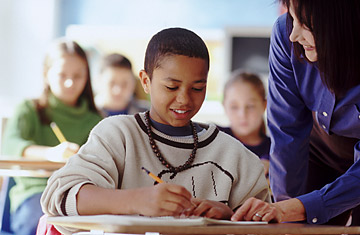
Achievement Gaps: How Black and White Students in Public Schools Perform in Mathematics and Reading on the National Assessment of Educational Progress
U.S. Department of Education
80 pages
The Gist:
Narrowing the persistent gap in achievement between white and minority students is one of the toughest challenges in education. In its first major report during the Obama Administration, the Department of Education offers one of the most comprehensive looks yet at the achievement gap between white and black pupils, based on the National Assessment of Educational Progress. The NAEP (pronounced nape) is a federal standardized test — known as "the nation's report card" — administered to fourth- and eighth-grade public-school students in reading and math. The state-by-state results show clear evidence of a continued problem: black students trail their white classmates in every state. But the report also offers some encouraging signs: overall scores have risen, and racial disparities are gradually shrinking in most areas, especially among younger students. Curiously, the South — the region traditionally hit hardest by the achievement gap — has been faring relatively well in bridging the gulf. Some Northern and Midwestern states that pride themselves on strong public-school systems, meanwhile, have been flustered as the gap persists and, in some cases, even widens.
Highlight Reel:
1. The bad: Black students trail white students in reading and math in every state. The average overall gap in fourth and eighth grades was 26 points on the 500-point NAEP. Some areas saw an even larger disparity: Massachusetts, for instance, had a 40-point gap in eighth-grade math.
2. The good: Scores for all students have risen since the NAEP was first administered, and the achievement gap narrowed by an average of 7 points from 1992 to 2007 (the date of the most recent test). Black fourth-graders have gained meaningful ground in math and reading since the test was first administered, in the early 1990s, while eighth-graders have made slight progress.
3. A problem: The report is not good news for Wisconsin. Excluding the District of Columbia, the Badger State had the nation's largest achievement gap in three of four areas: fourth- and eighth-grade reading as well as fourth-grade math. As in many Northern and Midwestern states, Wisconsin's white students generally perform well, providing a stark contrast to its underperforming minorities. Conversely, the small achievement gap in places like West Virginia (with a racial divide of just 13 points in fourth-grade reading) can prove a mixed blessing, as it often indicates that white students are missing the mark as well.
The Lowdown:
For states with otherwise strong school systems, these striking findings should serve as a wake-up call that not all students are thriving in their classrooms. Tallying data on the achievement gap is crucial to diagnosing the problem, but making real progress will require understanding the source of such persistent disparities and discovering meaningful remedies. On those subjects, unfortunately, the report is silent.
The Verdict: Skim.
